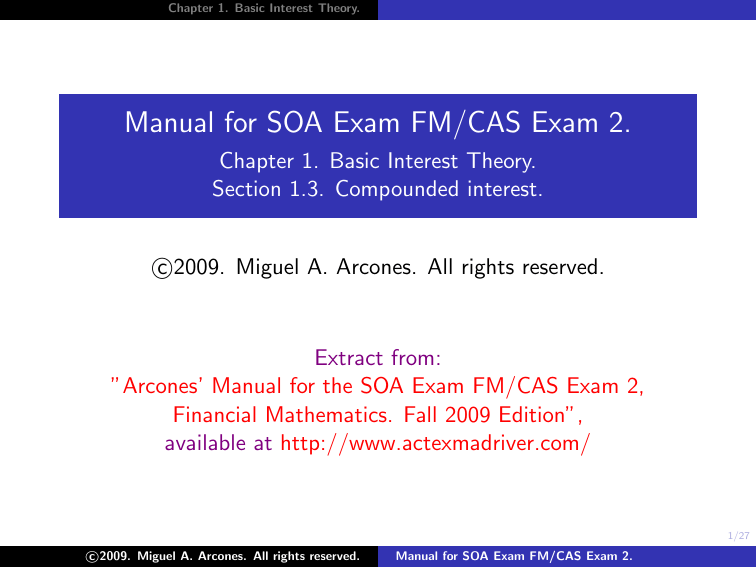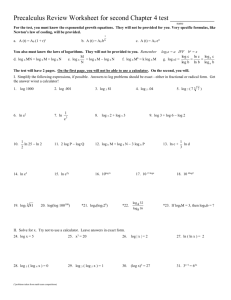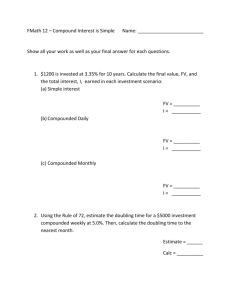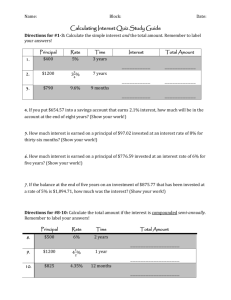
Chapter 1. Basic Interest Theory.
Manual for SOA Exam FM/CAS Exam 2.
Chapter 1. Basic Interest Theory.
Section 1.3. Compounded interest.
c
2009.
Miguel A. Arcones. All rights reserved.
Extract from:
”Arcones’ Manual for the SOA Exam FM/CAS Exam 2,
Financial Mathematics. Fall 2009 Edition”,
available at http://www.actexmadriver.com/
1/27
c
2009.
Miguel A. Arcones. All rights reserved.
Manual for SOA Exam FM/CAS Exam 2.
Chapter 1. Basic Interest Theory.
Section 1.3. Compounded interest.
Compound interest
Under compound interest the amount function is
A(t) = A(0)(1 + i)t , t ≥ 0,
where i is the effective annual rate of interest.
2/27
c
2009.
Miguel A. Arcones. All rights reserved.
Manual for SOA Exam FM/CAS Exam 2.
Chapter 1. Basic Interest Theory.
Section 1.3. Compounded interest.
Compound interest
Under compound interest the amount function is
A(t) = A(0)(1 + i)t , t ≥ 0,
where i is the effective annual rate of interest.
Under compound interest, the effective rate of interest over a
certain period of time depends only on the length of this period, i.e.
for each 0 ≤ s < t,
A(t − s) − A(0)
A(t) − A(s)
=
.
A(s)
A(0)
Notice that
A(t) − A(s)
A(0)(1 + i)t − A(0)(1 + i)s
=
= (1 + i)t−s − 1.
A(s)
A(0)(1 + i)s
The effective rate of interest earned in the n–th year is
in =
A(n) − A(n − 1)
A(0)(1 + i)n − A(0)(1 + i)n−1
=
= i.
A(n − 1)
A(0)(1 + i)n−1
3/27
c
2009.
Miguel A. Arcones. All rights reserved.
Manual for SOA Exam FM/CAS Exam 2.
Chapter 1. Basic Interest Theory.
Section 1.3. Compounded interest.
Under compound interest, the present value at time t of a deposit
of k made at time s is
kA(t)
kA(0)(1 + i)t
=
= k(1 + i)t−s .
A(s)
A(0)(1 + i)s
4/27
c
2009.
Miguel A. Arcones. All rights reserved.
Manual for SOA Exam FM/CAS Exam 2.
Chapter 1. Basic Interest Theory.
Section 1.3. Compounded interest.
Under compound interest, the present value at time t of a deposit
of k made at time s is
kA(t)
kA(0)(1 + i)t
=
= k(1 + i)t−s .
A(s)
A(0)(1 + i)s
If deposits/withdrawals are made according with the table
Deposits
Time (in years)
C1
t1
C2
t2
···
···
Cn
tn
where 0 ≤ t1 < t2 < · · · < tn , into an account earning compound
interest with an annual effective rate of interest of i, then the
present value at time t of the cashflow is
V (t) =
n
X
Cj (1 + i)t−tj .
j=1
In particular,
value of the considered cashflow at time
Pn the present
−t
j
zero is j=1 Cj (1 + i) .
c
2009.
Miguel A. Arcones. All rights reserved.
Manual for SOA Exam FM/CAS Exam 2.
5/27
Chapter 1. Basic Interest Theory.
Section 1.3. Compounded interest.
Example 1
A loan with an effective annual interest rate of 5.5% is to be
repaid with the following payments:
(i) 1000 at the end of the first year.
(ii) 2000 at the end of the second year.
(iii) 5000 at the end of the third year.
Calculate the loaned amount at time 0.
6/27
c
2009.
Miguel A. Arcones. All rights reserved.
Manual for SOA Exam FM/CAS Exam 2.
Chapter 1. Basic Interest Theory.
Section 1.3. Compounded interest.
Example 1
A loan with an effective annual interest rate of 5.5% is to be
repaid with the following payments:
(i) 1000 at the end of the first year.
(ii) 2000 at the end of the second year.
(iii) 5000 at the end of the third year.
Calculate the loaned amount at time 0.
Solution: The cashflow of payments to the loan is
Payments
Time
1000
1
2000
2
5000
3
The loaned amount at time zero is the present value at time zero
of the cashflow of payments, which is
(1000)(1.055)−1 + (2000)(1.055)−2 + (5000)(1.055)−3
=947.8672986 + 1796.904831 + 4258.068321 = 7002.840451.
7/27
c
2009.
Miguel A. Arcones. All rights reserved.
Manual for SOA Exam FM/CAS Exam 2.
Chapter 1. Basic Interest Theory.
Section 1.3. Compounded interest.
The accumulation function for simple interest is a(t) = 1 + it,
which is a linear function.
The accumulation function for compound interest is
a(t) = (1 + i)t , which is an increasing convex function.
We have that
(i) If 0 < t < 1, then (1 + i)t < 1 + it.
(ii) If 1 < t, then 1 + it < (1 + i)t .
8/27
c
2009.
Miguel A. Arcones. All rights reserved.
Manual for SOA Exam FM/CAS Exam 2.
Chapter 1. Basic Interest Theory.
Section 1.3. Compounded interest.
Figure 1: comparison of simple and compound accumulation functions
9/27
c
2009.
Miguel A. Arcones. All rights reserved.
Manual for SOA Exam FM/CAS Exam 2.
Chapter 1. Basic Interest Theory.
Section 1.3. Compounded interest.
Usually, we solve for variables in the formula, A(t) = A(0)(1 + i)t ,
using the TI–BA–II-Plus calculator.
To turn on the calculator press ON/OFF .
To clear errors press CE/C . It clears the current displays
(including error messages) and tentative operations.
When entering a number, you realized that you make a mistake
you can clear the whole display by pressing CE/C .
When entering numbers, if you would like to save some of the
entered digits, you can press → as many times as digits you
would like to remove. Digits are deleted starting from the last
entered digit.
It is recommended to set–up the TI-BA–II–Plus calculator to 9
decimals. You can do that doing
2nd , FORMAT , 9 , ENTER , 2nd , QUIT .
10/27
c
2009.
Miguel A. Arcones. All rights reserved.
Manual for SOA Exam FM/CAS Exam 2.
Chapter 1. Basic Interest Theory.
Section 1.3. Compounded interest.
We often will use the time value of the money worksheet of the
calculator. There are 5 main financial variables in this worksheet:
I
The number of periods N .
I
The nominal interest for year I/Y .
I
The present value PV .
I
The payment per period PMT .
I
The future value FV .
You can use the calculator to find one of these financial variables,
by entering the rest of the variables in the memory of the
calculator and then pressing CPT financial key , where financial
key is either N , % i , PV , PMT or FV .
11/27
c
2009.
Miguel A. Arcones. All rights reserved.
Manual for SOA Exam FM/CAS Exam 2.
Chapter 1. Basic Interest Theory.
Section 1.3. Compounded interest.
Here, financial key is either N , % i , PV , PMT or FV .
I
You can recall the entries in the time value of the money
worksheet, by pressing RCL financial key .
I
To enter a variable in the entry financial key , type the entry
and press financial key . The entry of variables can be done
in any order.
I
To find the value of any of the five variables (after entering
the rest of the variables in the memory) press CPT
financial key .
I
When computing a variable, a formula using all five variables
and two auxiliary variables is used
12/27
c
2009.
Miguel A. Arcones. All rights reserved.
Manual for SOA Exam FM/CAS Exam 2.
Chapter 1. Basic Interest Theory.
Section 1.3. Compounded interest.
To set–up C/Y =1 and P/Y =1, do
2nd , P/Y , 1 , ENTER , ↓ , 1 , ENTER , 2nd , QUIT .
To check that this is so, do
2nd P/Y ↓ 2nd QUIT .
If PMT equals zero, C/Y =1 and P/Y =1, you have the
formula,
− N
I/Y
PV + FV 1 +
= 0.
100
(1)
You can use this to solve for any element of the four elements in
the formula A(t) = A(0)(1 + i)t . Unless it is said otherwise, we
will assume that the entries for C/Y and P/Y are both 1
and PMT is 0.
c
2009.
Miguel A. Arcones. All rights reserved.
13/27
Manual for SOA Exam FM/CAS Exam 2.
Chapter 1. Basic Interest Theory.
Section 1.3. Compounded interest.
Example 2
Mary invested $12000 on January 1, 1995. Assuming composite
interest at 5 % per year, find the accumulated value on January 1,
2002.
14/27
c
2009.
Miguel A. Arcones. All rights reserved.
Manual for SOA Exam FM/CAS Exam 2.
Chapter 1. Basic Interest Theory.
Section 1.3. Compounded interest.
Example 2
Mary invested $12000 on January 1, 1995. Assuming composite
interest at 5 % per year, find the accumulated value on January 1,
2002.
Solution: A(t) = 12000(1 + 0.05)7 = 16885.21. You can do this
in the calculator by entering:
0 PMT 7 N 5 I/Y 12000 PV CPT FV .
Note that since the calculator, uses the formula
PV + FV 1 +
I/Y
100
− N
= 0.
the display in your calculator is negative.
15/27
c
2009.
Miguel A. Arcones. All rights reserved.
Manual for SOA Exam FM/CAS Exam 2.
Chapter 1. Basic Interest Theory.
Section 1.3. Compounded interest.
Example 3
At what annual rate of compound interest will $200 grow to $275
in 5 years?
16/27
c
2009.
Miguel A. Arcones. All rights reserved.
Manual for SOA Exam FM/CAS Exam 2.
Chapter 1. Basic Interest Theory.
Section 1.3. Compounded interest.
Example 3
At what annual rate of compound interest will $200 grow to $275
in 5 years?
Solution: We solve for i in 275 = 200(1 + i)5 and get
i = 6.5763%. In the calculator, you do
−275 FV 5 N 200 PV CPT I/Y .
Since the calculator, uses the formula (1), either the present value
or the future value has to be entered as negative number (and the
other one as a positive number). If you enter both the present
value and the future value as positive values, you get the error
message Error 5 . To clear this error message press CE/C .
17/27
c
2009.
Miguel A. Arcones. All rights reserved.
Manual for SOA Exam FM/CAS Exam 2.
Chapter 1. Basic Interest Theory.
Section 1.3. Compounded interest.
Example 4
How many years does it take $200 grow to $275 at an effective
annual rate of 5%?
18/27
c
2009.
Miguel A. Arcones. All rights reserved.
Manual for SOA Exam FM/CAS Exam 2.
Chapter 1. Basic Interest Theory.
Section 1.3. Compounded interest.
Example 4
How many years does it take $200 grow to $275 at an effective
annual rate of 5%?
Solution: We solve for t in 275 = 200(1 + 0.05)t and get that
t = 6.5270 years. In the calculator, you do
−275 FV 5 I/Y 200 PV CPT N .
19/27
c
2009.
Miguel A. Arcones. All rights reserved.
Manual for SOA Exam FM/CAS Exam 2.
Chapter 1. Basic Interest Theory.
Section 1.3. Compounded interest.
Example 5
At an annual effective rate of interest of 8% how long would it
take to triple your money?
20/27
c
2009.
Miguel A. Arcones. All rights reserved.
Manual for SOA Exam FM/CAS Exam 2.
Chapter 1. Basic Interest Theory.
Section 1.3. Compounded interest.
Example 5
At an annual effective rate of interest of 8% how long would it
take to triple your money?
Solution: We solve for t in 3 = (1 + 0.08)t and get t = 14.2749
years. In the calculator, you do
−3 FV 8 I/Y 1 PV CPT N .
21/27
c
2009.
Miguel A. Arcones. All rights reserved.
Manual for SOA Exam FM/CAS Exam 2.
Chapter 1. Basic Interest Theory.
Section 1.3. Compounded interest.
Example 6
How much money was needed to invest 10 years in the past to
accumulate $ 10000 at an effective annual rate of 5%?
22/27
c
2009.
Miguel A. Arcones. All rights reserved.
Manual for SOA Exam FM/CAS Exam 2.
Chapter 1. Basic Interest Theory.
Section 1.3. Compounded interest.
Example 6
How much money was needed to invest 10 years in the past to
accumulate $ 10000 at an effective annual rate of 5%?
Solution: We solve for A(0) in 10000 = A(0)(1 + 0.05)10 and get
that A(0) = 6139.13. In the calculator, you do
10000 FV 5 I/Y 10 N CPT PV .
23/27
c
2009.
Miguel A. Arcones. All rights reserved.
Manual for SOA Exam FM/CAS Exam 2.
Chapter 1. Basic Interest Theory.
Section 1.3. Compounded interest.
The calculator has a memory worksheet with values in the memory,
which stores ten numbers. These ten numbers are called: M0 ,
· · · , M9 .To enter the number in the display into the i–th entry of
the memory, press STO i , where i is an integer from 0 to 9. To
recall the number in the memory entry i, press RCL i , where i is
an integer from 0 to 9. The command STO + i adds the
value in display to the entry i in the memory. You can see all the
numbers in the memory by accessing the memory worksheet. To
enter this worksheet press 2nd MEM . Use the arrows ↑ , ↓ to
move from entry to another. To entry a new value in one entry,
type the number and press ENTER .
24/27
c
2009.
Miguel A. Arcones. All rights reserved.
Manual for SOA Exam FM/CAS Exam 2.
Chapter 1. Basic Interest Theory.
Section 1.3. Compounded interest.
Example 7
A loan with an effective annual interest rate of 5.5% is to be
repaid with the following payments:
(i) 1000 at the end of the first year.
(ii) 2000 at the end of the second year.
(iii) 5000 at the end of the third year.
Calculate the loaned amount at time 0.
25/27
c
2009.
Miguel A. Arcones. All rights reserved.
Manual for SOA Exam FM/CAS Exam 2.
Chapter 1. Basic Interest Theory.
Section 1.3. Compounded interest.
Example 7
A loan with an effective annual interest rate of 5.5% is to be
repaid with the following payments:
(i) 1000 at the end of the first year.
(ii) 2000 at the end of the second year.
(iii) 5000 at the end of the third year.
Calculate the loaned amount at time 0.
Solution: The cashflow of payments to the loan is
Payments
Time
1000
1
2000
2
5000
3
The loaned amount at time zero is the present value at time zero
of the cashflow of payments, which is
(1000)(1.055)−1 + (2000)(1.055)−2 + (5000)(1.055)−3
=947.8672986 + 1796.904831 + 4258.068321 = 7002.840451.
26/27
c
2009.
Miguel A. Arcones. All rights reserved.
Manual for SOA Exam FM/CAS Exam 2.
Chapter 1. Basic Interest Theory.
Section 1.3. Compounded interest.
Using the calculator, you do
−1000 FV 1 N 5.5 I/Y CPT PV
and get (1000)(1.055)−1 = 947.8672986. You enter this number in
the memory of the calculator doing STO 1
Next doing
−2000 FV 2 N CPT PV
you find (2000)(1.055)−2 = 1796.904831. Notice that you do not
have to reenter the percentage interest rate. You enter this
number in the memory of the calculator doing STO 2
Next doing
−5000 FV 3 N CPT PV
you get (5000)(1.055)−3 = 4258.068321. You enter this number in
the memory of the calculator doing STO 3 .
You can recall and add the three numbers doing
CRCL 1 + CRCL 2 + CRCL 3 =
and get 7002.840451.
27/27
c
2009.
Miguel A. Arcones. All rights reserved.
Manual for SOA Exam FM/CAS Exam 2.










